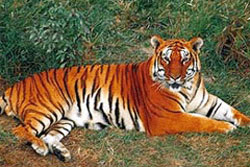Jungle Safari - Bardia National Park
Bardia Jungle safari
 The Bardia National Park is situated on the eastern banks of the Karnali river, about 400 kms. west of Kathmandu. The park is 968 sq kms. in area and extends from the Churia hills southward to the gentle slopes of the "Bhabhar'. The higher grounds of the Churia have dry deciduous forest of mostly hardwood sal. The porous slopes of the Bhabhar support large open grasslands known locally as 'Phantas'. These are some of the last remaining grasslands that once covered much of the Gangetic plains.
The Bardia National Park is situated on the eastern banks of the Karnali river, about 400 kms. west of Kathmandu. The park is 968 sq kms. in area and extends from the Churia hills southward to the gentle slopes of the "Bhabhar'. The higher grounds of the Churia have dry deciduous forest of mostly hardwood sal. The porous slopes of the Bhabhar support large open grasslands known locally as 'Phantas'. These are some of the last remaining grasslands that once covered much of the Gangetic plains.
The western end of the Bardia is bounded by numerous water-ways of the Karnali which have created many large and small gravel islands. These islands and much of the lower ground area covered by a mosaic of grassland and riverine forest of acacia, sisam and the large buttressed silk cotton trees. In spring, the silk cotton blooms and the forest comes alive with scarlet flowers.
Bardia is the home of a wide variety of animals, many of which live in and around the Phantas. These open grasslands such as Baghora and Lamkoili are the best places to view animals. The most conspicuous of which is the spotted deer. Other ungulates include black buck, hog deer, samber deer, wild boar and barasingha or swamp deer. Two species of monkeys, the langur and the rhesus macaque are also present. The park is famous for its small herds of wild elephants which are rarely seen. The park also boasts a small population of the rare gharial, the marsh mugger crocodile and the Gangetic dolphin. The island of the Karnali river harbours the sub-continent's largest antelope species, the nilgai or blue bull. The Karnali and Babai rivers attract a large number of wintering waterfowl along with resident species such as herons, kingfishers and wall creepers. More than 350 bird species have been recorded in Bardia, truly a bird watcher's paradise.
Access:
To reach Bardia, take the daily flight or public bus from Kathmandu to Nepalgunj, from where it is a five hour drive to the park office at Thakurdwara. This nature sanctuary is best visit form October to April.



